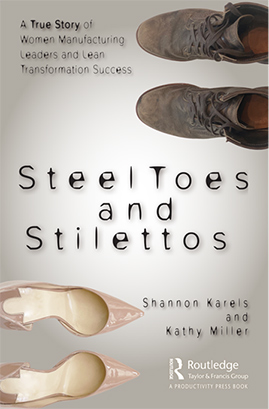Find ways to enhance meaningful work during the lean transformation process for positive business outcomes.

By: Kathy Miller, MAPP, MBA
The trend to implement lean manufacturing has been in motion for decades. Lean manufacturing seeks to optimize material flow through factories by reducing wastes associated with non-value-added tasks, variability, and overburden. However, lean manufacturing principles can be challenging to implement in a meaningful way for all members of a production system. Many lean tools are implemented to create flow throughout a factory to improve productivity and quality. As the system is implemented, the work may fall flat in creating or enhancing the meaning of the work performed by all team members.
For example, a foundational tool of an effective lean manufacturing system is standardized work. This tool defines a job by breaking it down into essential elements and identifying standardized methods for performing the work that is repeatable by whoever is performing that work. In this quest for efficiency, employees can become distanced from the valuable experience of making meaningful contributions in the course of their daily profession. If implementing a lean operating system is to be effective, it is incumbent upon the business leadership to seek ways that work remains meaningful for all team members.
In many factories, a large portion of the team members creating the value is not connected directly with the final stages of the product. It is difficult for team members to see the significance of the task(s) they are performing. One way to create meaning for people who are producing discreet components or sub-assemblies is to create marketing or communication campaigns to inform all workforce members how their products or their customers’ products positively impact the world.
In one of the many organizations I led in which lean manufacturing principles were being implemented as part of a comprehensive transformation, the product was elastomeric parts. In the early days of the implementation process, we established many lean tools and concepts that contributed to productivity improvements. These included designing manufacturing cells that minimized unnecessary operator movement, providing the rubber compound to the press operators’ point of use, and creating standard work documentation for the best and most efficient way to handle the molds to maximize production. The workforce was compliant but not inspired. The leadership team explained why the lean manufacturing tools were being implemented: to generate value for the customer and better profitability for the business. Still, there was no sense of passion or excitement from the workforce. Progress was slow, at best.
As a result, I commissioned our sales team to help create a communication and marketing campaign about where these rubber parts of various colors, sizes, and shapes, were ultimately used. We created signs and banners displaying how the end products were used and placed them in the factory where the associated parts were made. We invited customers to share stories with all of our team members about how the fruits of their daily labor contributed to meeting the essential needs of humankind. Once a source of many factory jokes, “chicken plucker fingers” became critical parts necessary for feeding people. Another source of “witty” remarks, “casket gaskets,” came to be viewed as a source of comfort to the families of deceased relatives. One of the products that were sourced through this organization sealed the hydration units the military carried when they pursued a well-known international terrorist – and it was that hydration unit that was used to spray the terrorist’s face with water to confirm his identity. The team felt they had contributed to the safety and security of the world. These connections brought life and meaning to rubber parts, which had previously been mere oddities. They became a source of pride for the workforce. They gave meaning to the daily tasks performed by our team members.
Another way to provide meaning is to include people in the improvement process as the work changes to be more efficient. People who perform the work are valuable resources for ideas that will make the work better. Transformation through the use of lean methodologies should be done collaboratively and respectfully with all the people who perform the work. Inclusive improvement processes are more meaningful to employees than initiatives that dictate process changes, and consequently, in my experience, create better and more sustainable results.
Numerous studies examine the relationship among meaningful work, work engagement, and organizational commitment, pointing to positive relationships among the three. Studies, such as those conducted by E. W. Rogers at the University of Alabama Huntsville, http://dx.doi.org/10.1016/S1047-8310(00)00038-9 have linked organizational commitment and employee engagement with positive business outcomes such as employee retention and improved productivity.
The technical aspects of the lean manufacturing toolset are readily available, as many have been pursuing it for decades. However, the long-term success of lean manufacturing operations needs to marry these tools with the principles of human psychology and employee motivation, such as providing the opportunity for people to find meaning in their work.

Kathy Miller is an Executive Coach and Business Transformation Advisor. She has held numerous Senior Operations Executive roles including plant operations manager, general manager, global vice president and global director at General Motors/Delphi Automotive Systems, Parker Hannifin, Rolls-Royce, and Vertiv Corporations. Kathy holds a Bachelor of Science Degree in Industrial & Systems Engineering from Kettering University, a Master’s Degree of Business Administration from Ball State University, and a Master’s Degree in Applied Positive Psychology from the University of Pennsylvania. She is a Shingo Prize Recipient for Large Businesses as a Plant Operations Manager (2004) and was inducted into the Women in Manufacturing Hall of Fame in 2021. Kathy is co-author of Steel Toes and Stilettos: A True Story of Women Manufacturing and Lean Transformation Success (Dec 2021, Taylor & Francis).

The authors joined forces professionally when Kathy hired Shannon to be a member of her leadership team. This book describes the transformation they led to convert operations from traditional manufacturing to a lean enterprise.
Kathy(executive leader responsible for profitability) and Shannon (transformation leader) share the finer points of a comprehensive change process, the challenges and triumphs, and the real emotion involved during their quest for success. Each describes the professional journey from their unique perspective and the highlights of an endearing friendship that was formed along the way.
This story will inspire female leaders in any organization, showcasing an example of high-performing women thriving in an intense and fast-aced world. Kathy and Shannon are role models for those juggling intense, fulfilling careers, alongside life’s complexities such as dual-career marriages and raising children.
Their story provides a powerful case study of women supporting each other in the workplace to drive positive culture and significantly improved business results be leading with authenticity and inclusivity.
In this episode, I sat down with Beejan Giga, Director | Partner and Caleb Emerson, Senior Results Manager at Carpedia International. We discussed the insights behind their recent Industry Today article, “Thinking Three Moves Ahead” and together we explored how manufacturers can plan more strategically, align with their suppliers, and build the operational discipline needed to support intentional, sustainable growth. It was a conversation packed with practical perspectives on navigating a fast-changing industry landscape.